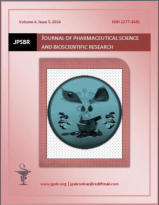

Journal of
Pharmaceutical Science and
Bioscientific Research
ISSN 2277 - 3681
Indexing & Listing
Impact Factor-2.633
Peer Reviewed



Formulation and Evaluation of Melt In Mouth Tablet Of Perphenazine
Nishith Patel*, Shashtri Yashesh



Awareness on Lymphatic Filariasis: A Chain continues for Elimination
Janam Desai, Sanket Desai, Patel Nidhi, Chirag Desai




Volume 4, Issue 6
Pages no. 335-367

Awareness on Malaria in Industrial town Vapi: An Initiative
Aarti Panchal, Krupali Dave, Prachi Desai, Chirag Desai





Awareness on Lymphatic Filariasis: An Initiative for Elimination
Chandani Desai, Arzoo Gouri, Krunal Bhandari, Chirag Desai





Analytical Method Development and Validation for Simultaneous Estimation of Timolol Maleate and Brimonidine
Tartrate in Bulk and Marketed Ophthalmic Formulation
Suketa K. Mehta*, Dr. Dilip G. Maheshwari





Community Awareness on Sickle cell anemia in Tribal area: An Initiative
Chirag Desai, Krunal Bhandari, Dr. Atul M Desai, Dr. Biren Shah






Awareness on Sickle Cell Anemia in Higher Secondary School Students of Tribal Area: An Initiative
Chirag Desai, Krunal Bhandari, Dr. Atul M Desai, Dr. Biren Shah






© JPSBR Publications 2011-2024
Powered by Opus
Exploration of Effects of Superdisintegrant in the Fast Disintegrating Tablet Formulation
Nayankumar C. Ratnakr*, Tushar M. Patel, Dhaval V. Madat, Divyeshkumar B. Doshi, Beenkumar R. Prajapati





RP-HPLC Method Development and Validation using Factorial Design for Simultaneous Estimation of
Thiocolchicoside and Etodolac with Forced Degradation Studies
Alisha Patel, Biren Shah





Development and Validation of Area Under Curve Method for Simultaneous Estimation of Thiocolchicoside and
Lornoxicam in Tablet Dosage Form
Alisha Patel, Biren Shah




ABSTRACT:
This
work
approached
with
to
formulate
directly
compressible
fast
disintegrating
tablets
of
Cinnarizine
with
sufficient
mechanical
integrity,
content
uniformity,
and
acceptable
palatability
to
assist
patients
of
any
age
group
for
easy
administration.
Effect
of
concentration
of
superdisintegrant,
Kyron
T
314
and
directly
compressible
material,
tablettose®
70
on
disintegration
time
was
studied.
Tablets
were
evaluated
for
weight
variation,
thickness,
hardness,
friability,
drug
content,
in
vitro
disintegrating
time,
wetting
time
and
in
vitro
drug
release.
A
32
full
factorial
design
was
applied
to
investigate
the
combine
effect
of
2
formulation
variable:
directly
compressible
material,
tablettose®
70
and
Superdisintegrant,
Kyron
T
314.
Here
the
concentration
of
directly
compressible
material
and
concentration
of
superdisintegrant
were
taken
as
independent
variable,
X1
and
X2
respectively.
The
effect
of
Disintegration
time,
wetting
time,
Q15
and
friability
were
investigated
as
dependent
parameters.
The
results
of
analysis
revealed
that
for
obtaining
a
rapidly
disintegrating
dosage
form,
tablets
should
be
prepared
using
an
optimum
concentration
of
superdisintegrant
and
a
higher
percentage
of
directly
compressible
material.
The
systematic
formulation
approach
helped
in
understanding
the
effect
of
formulation
processing variables.
Key words:
fast disintegrating tablet, Cinnarizine, 32 factorial design, tablettose® 70, Kyron T 314
![Close [x]](index_htm_files/close.png)
ABSTRACT:
The
survey
was
designed
to
investigate
about
the
awareness
of
higher
secondary
school
students
belongs
to
tribal
area
about
awareness,
the
inheritance,
symptoms
&
complications
and
management
and
government
facility
for
the
sickle
cell
anemia.
This
study
was
also
determine
whether
or
not
students
likely
to
be
genetically
affected
by
sickle
cell
anemia
are
more
or
less
aware.197
students
of
the
higher
secondary
school
were
assessed
on
their
general
awareness
about
sickle
cell
anemia
and
pamphlets
on
awareness
were
distributed
to
make
them
aware
and
spread
the
awareness
to
others
too.
Percentage
analysis
was
used
to
evaluate
the
results.
40%
students
were
aware
about
the
Sickle
cell
anemia
and
know
it
is
Autosomal
disease
and
32.5%
know
how
it
is
occurs
and
its
symptoms
and
complications.
Where
4%
were
aware
about
its
treatment
as
they
were
the
sufferer
of
sickle
cell
anemia
and
only
0.5%
knows
the
government
facility
for
Sickle
cell
anemia.
In
this
study
50%
were
boys
from
which
11%
aware
and
from
50%o
girls
26%
aware.
100%
were
interested
to
know
about
the
disease
and
were
ready
to
spread
awareness
on
the
disease
in
others.
The
scarcity
of
sickle
cell
anemia
research
exemplifies
how
our
society
fails
to
view
sickle
cell
anemia
as
a
serious
illness.
Information
and
awareness-related
activities
are
important
component
of
effective
public
health
strategies
for
reducing
the
morbidity
and
mortality
among
people
with
sickle
cell
anemia.
Without
awareness and a public protest for a revolution, sickle cell anemia will continue to be a silent killer to young people around the world.
Keywords: Sickle cell anemia, awareness, Sickle cell anemia in Students of Tribal
![Close [x]](index_htm_files/close.png)
ABSTRACT:
Objective:
A
survey
was
conducted
to
know
and
spread
awareness
in
people
on
various
aspects
of
sickle
cell
anemia,
like
do
they
know,
what
it
is
and
how
it
is
occurs,
basic
treatments,
and
contingency
and
to
know
if
they
have
sickle
cell
or
not
will
help
in
estimation
of
disease
in
tribal
area
of
Valsad District, Gujarat.
Methodology:
A
well
designed
questionnaire
and
leaflet
about
disease
was
prepared
with
the
help
of
clinical
pharmacist
and
physician.
With
an
initiative
to
spread
awareness
and
estimating
cases
of
sickle
cell
anemia
we
received
fully
filled
100
forms
and
dispatch
leaflets
on
the
disease
spreading community awareness. A percentage analysis for each question was carried out.
Result:
26%
people
were
aware
about
the
Sickle
cell
anemia
and
know
it
is
autosomal
disease.
25%
people
know
how
it
is
occurs
and
aware
about
its
contingency
and
basic
treatment.3%
were
the
sufferer
of
sickle
cell
anemia
and
only
1%
know
the
government
facility
for
them.
In
this
study
46%
were
male
and
54%
were
female,
60%
were
interested
to
know
about
the
disease
but
only
2%
were
ready
to
spread
awareness
on
the
disease
in
others as only 10% were graduates so it might be the cause of less involvement.
Conclusion:
As
sickle
cell
anemia
is
a
disease
affects
in
tribal
area,
there
is
a
much
need
to
spread
awareness
in
tribal
areas
to
improve
healthcare
sector
of
the
country.
For
the
improvement
of
healthcare
of
tribal's
through
community
awareness
is
an
initiative
to
lifting
up
the
community
healthcare.
Keywords:
Sickle cell anemia, Awareness, Valsad
![Close [x]](index_htm_files/close.png)
ABSTRACT:
A
new,
simple,
precise,
accurate
and
sensitive
High
Performance
Thin
Layer
Chromatographic
method
has
been
developed
for
the
estimation
of
Timolol
Maleate
and
Brimonidine
Tartrate
in
bulk
and
marketed
ophthalmic
formulation.
The
determination
was
made
at
268
nm
for
Timolol
Maleate
and
Brimonidine
Tartrate
over
the
concentration
range
of
500-1500
ng/spot
and
200-600
ng/spot
respectively.
The
mean
recovery
of
Timolol
Maleate
and
Brimonidine
Tartrate
was
found
99.40%
and
99.14%
respectively.
The
LOD
was
found
to
be
65.33
ng/spot
and
48.20
ng/spot
for
Timolol
Maleate
and
Brimonidine
Tartrate
respectively.
The
LOQ
was
found
to
be
197.97
ng/spot
and
146.08
ng/spot
for
Timolol
Maleate
and
Brimonidine
Tartrate
respectively.
Chloroform:
Methanol:
Ammonia
(30%)
(9:1:0.1
v/v/v)
was
selected
as
a
mobile
phase.
The
validation
of
method
was
carried
out
as
per
ICH Guidelines.
Keywords:
Timolol Maleate, Brimonidine Tartrate, High Performance Thin Layer Chromatographic Method, Validation, Combigan Eye-Drops.
![Close [x]](index_htm_files/close.png)
ABSTRACT:
Objective:
An
survey
was
conducted
to
know
and
spread
awareness
in
people
on
various
aspects
of
Filaria,
like
causative
organism,
basic
treatments,
tendency
to
consume
tablet
and
to
know
if
they
have
seen
or
observe
any
cases
which
is
also
helpful
in
estimation
of
disease
burden
in
particular
area. This survey was conducted with an intention to support government Filaria elimination program.
Methodology:
A
well
designed
questionnaire
and
leaflet
on
awareness
was
prepared
with
the
help
of
clinical
pharmacist
and
standard
WHO
questionnaire
format.
With
door
to
door
communication
and
spreading
awareness
we
have
received
fully
filled
100
forms
and
dispatch
leaflets
on
disease awareness. A percentage analysis for each question was carried out.
Results:
From
the
study
the
data
suggest
that,
80%
aware
about
the
lymphatic
Filariasis.
65
%
people
were
aware
about
the
cause
of
spreading,
60%
were
aware
about
its
contingency.
95%
people
have
received
annual
medication
from
nurses
as
per
government
program
out
of
which
only
41%
people
have
consume
the
tablets.
44%
have
seen
the
Filaria
cases
which
help
in
studying
the
epidemics.100%
people
have
shown
willingness
to
know about the disease and 100% have assured to help in spreading the awareness to others.
Conclusion:
From
the
result
on
awareness
on
Filaria
in
semirural
area
was
around
80%
and
we
were
able
to
find
the
presence
of
case
of
Filaria
in
Killa-Pardi,
Valsad.
This
might
be
helpful
to
the
government
in
mapping
the
disease.
The
low
percentage
in
medication
taking
behavior
needs
to
be
improved by awareness programs like this.
Keywords:
Lymphatic Filariasis, Awareness, Killa-Pardi, Valsad
![Close [x]](index_htm_files/close.png)
ABSTRACT:
Objective:
A
survey
was
conducted
to
know
and
spread
awareness
in
people
on
various
aspects
of
malaria,
like
spread,
pre-disposing
factors,
control
&
effects of malaria in people of industrial town, Vapi.
Methodology:
In
a
cross
sectional
design
study
a
well
designed
questionnaire
and
leaflet
about
Malaria
was
prepared
with
the
help
of
clinical
pharmacist
and
standard
format
with
an
initiative
to
communicate
and
spread
awareness
we
received
200
forms
fully
filled
by
participants
and
dispatch
leaflets.
A
percentage analysis for each question was carried out.
Result:
81.5%
people
were
aware
about
the
Malaria,
where
97%
were
know
mosquito
bite
is
the
cause
and
garbage
is
the
common
breeding
site
and
sunset
is
common
bite
time,
the
main
symptom
were
fever
99%,
and
shivering
45%.
Only
2%
know
the
name
of
mosquito
vector
while
98%
have
no
idea
about
vector
name.
Knowledge
of
preventive
measures
included
use
of
Repellent
and
fan
(99%),
cleaning
house(100%)
and
use
of
smoke(86%).97%
were not having any idea about the medicines.13% were only graduate and only 1% were having >15000 monthly income.
Conclusion:
Although
community
is
aware
about
malaria
(81.5%)
but
still
require
adequate
knowledge
on
clinical
features
of
it.
So
awareness
programs
on
Malaria
and
other
parasitic
disease
have
to
be
conducted
for
the
improvement
of
healthcare.
Health
education
and
awareness
is
a
best
way
for
lifting
up
the community healthcare. This initiative helps the government in control of the disease.
Keywords:
Malaria, Awareness, Vapi, community is aware about malaria
![Close [x]](index_htm_files/close.png)
ABSTRACT:
Objective:
A
survey
was
conducted
to
know
and
spread
awareness
in
people
of
village
Kharsad,
Navsari
district
on
various
aspects
of
Filaria,
like
causative
organism,
basic
treatments,
tendency
to
consume
tablet
and
to
know
if
they
have
seen
any
cases
which
is
also
helpful
in
estimation
of
disease
burden in particular area. This survey was conducted with an intention to support government Filaria elimination program.
Methodology:
A
deliberate
questionnaire
and
pamphlet
on
awareness
was
prepared
with
the
help
of
clinical
pharmacist
and
Physician.
Communicated
and
received
fully
filled
100
forms
and
dispatch
pamphlets
on
disease
awareness
with
an
initiative
to
person
to
person
communication
spreading
awareness. A percentage analysis for each question was carried out.
Results:
55%
aware
about
the
lymphatic
Filariasis.
15
%
people
were
aware
about
the
cause
of
spreading
and
it's
contingency.
98%
people
have
received
annual
medication
from
nurses
as
per
government
annual
elimination
program
out
of
which
90%
people
have
consume
the
tablets.
On
a
purpose
of
studying
epidemic
of
disease
4%
people
have
answered
that
they
have
seen
the
cases
of
Filaria.
90%
people
have
shown
willingness
to
know
about the disease and assured to help in spreading the awareness to others.
Conclusion:
From
the
result
on
awareness
on
Filaria
in
village
was
around
55%
but
still
the
medication
taking
behavior
is
90%
which
is
good
but
low
percentage in awareness within people can be improved by the awareness programs regularly like this to support the government.
Keywords:
Lymphatic Filariasis, Awareness, Kharsad, Navsari
![Close [x]](index_htm_files/close.png)
ABSTRACT:
In
the
present
work,
sensitive,
accurate,
precise
and
robust
RP-HPLC
method
been
developed
for
the
quantitative
estimation
of
Thiocolchicoside
(THC)
and
Etodolac
(ETD)
in
combined
tablet
dosage
form.
Determination
of
THC
and
ETD
was
carried
on
a
reverse
phase
C18
(250×4.6mm,
5µ)
column
using
a
mobile
phase
consisting
of
Acetonitrile:
Phosphate
Buffer
(60:40
v/v)
pH
5,
Flow
rate
of
1.0
ml/min
and
the
detection
was
carried
out
at
259
nm.
The
linearity
was
found
to
be
in
the
range
of
10-50
?g/ml
and
50-250
?g/ml
with
(r2=0.9999,
and
r2=0.9993)
for
THC
and
ETD
respectively.
The
sharp
peaks
obtained
were
having
clear
baseline
separation
with
a
retention
time
of
2.45
min
for
THC
and
7.10
min
for
ETD
with
resolution
16.55.
The
forced
degradation
studies
performed
in
acidic,
basic,
oxidative,
photolytic
and
thermal
conditions
at
different
time
intervals.
The
method
was
validated
as
per
the
International
Conference
on
Harmonization
(ICH)
guidelines
as
well
as
for
the
robustness
studies
the
Quality
by
Design
approach
used
based
on
3-
Level
Factorial
Design
of
Experiment.
On
the
basis
of
Designs
the
three
chromatographic
parameters
(Flow
Rate,
pH
and
Mobile
phase
composition)
were
changed
and
study
were
carried
out
with
effects
on
Retention
time
and
Peak
Area.
The
proposed
validated
method
was
successfully
used
for
the
quantitative analysis of commercially available dosage form.
KEY WORDS:
Thiocolchicoside, Etodolac, QbD based RP-HPLC, Factorial design, Forced degradation studies
![Close [x]](index_htm_files/close.png)
ABSTRACT:
Area
Under
Curve
Method
has
been
developed
for
the
quantitative
estimation
of
Thiocolchicoside
(THC)
and
Lornoxicam
(LNC)
in
combined
tablet
dosage
form.
The
wavelength
ranges
selected
for
estimation
of
THC
were
365
?
375
nm
(?1??2)
and
for
LNC
wavelength
ranges
selected
were
285
?
295
nm
(?3??4)
and
area
were
integrated
between
these
selected
wavelength
ranges
for
both
drugs.
The
method
was
linear
in
the
range
of
4-20
?g/ml
(r2
=
0.9998)
for
THC
and
4-20
?g/ml
(r2
=
0.9994)
for
LNC.
The
results
of
the
precision
study
indicate
that
the
proposed
method
showed
good
repeatability
for
THC
and
LNC
with
%
CV
of
0.16
%
and
0.28
%
respectively.
The
%
CV
for
intraday
precision
was
found
to
be
0.11
-
0.27
%
for
THC
and
0.16
-
0.44
%
for
LNC.
Similarly
%
CV
from
the
interday
precision
data
were
found
be
found
to
be
0.16
-
0.54
%
for
THC
and
0.28
-
0.62
%
for
LNC.
The
%
recoveries
for
THC
and
LNC
obtained
in
the
accuracy
study
were
99.25-100.41%
and
99.43-100.27%
respectively.
The
LOD
for
THC
and
LNC
was
found
to
be
0.0330
µg/ml
and
0.3588
µg/ml
respectively.
Similarly
LOQ
for
THC
and
LNC
was
found
to
be
0.1002
µg/ml
and
1.0875
µg/ml
respectively.
The
%
assay
results
of
99.20%
for
THC
and
99.42%
for
LNC
indicate
that
the
developed
method
was
successfully
utilised
for
the
estimation
of
THC
and
LNC in their tablet formulation.
KEY WORDS:
Thiocolchicoside, Lornoxicam, Area Under Curve method, simultaneous estimation.
![Close [x]](index_htm_files/close.png)



































































































![Close [x]](index_htm_files/close.png)



















